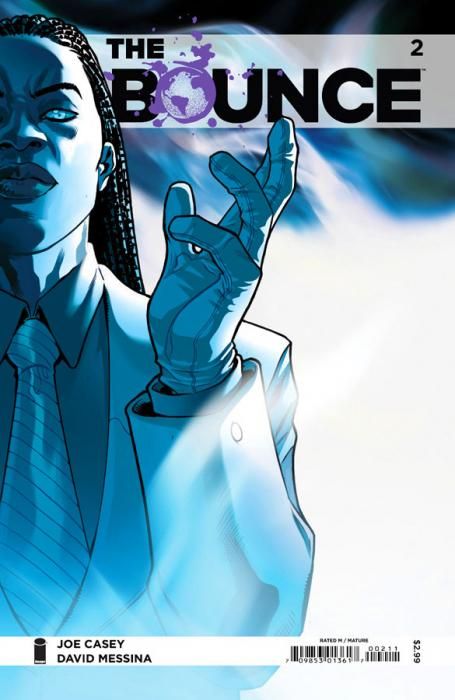"The Bounce" #2 by Joe Casey and David Messina follows the rest of The Bounce's day that began with the first issue. Jasper has a disturbing encounter with his old buddy Zander, and has a run-in with the law, and along the way, the origin of his powers is partially revealed.
The opening pages of "The Bounce" #2 are intentionally disorienting and difficult to decipher, since Casey and Messina want the reader to share in Jasper's confusion as much as possible. Casey's sharp dialogue is always a hook, even when the reader has no idea of what Jasper's friend Zander is going on about or what is really happening. Zander and Jasper's rhythms of speech are over-exaggerated, reinforcing the stylized surface of the "The Bounce."
Messina's art for these pages also contributes to this effect with angular and unrealistically smooth cityscapes and interiors. Niro's colors continue to be appropriately psychedelic in the right places as well, and his transitions from cool tones to warm tones help reinforce setting and timeline changes later on.
The plot of "The Bounce" #2 results more questions than answers. Zander dispenses to Jasper only cryptic hints instead of straightforward intelligence, in the old tradition of convoluted dream or drug logic. However, it's satisfying how Casey and Messina dish up some of The Bounce's origin story so early in the introductory storyline. In a flashback, Casey shows where The Bounce acquired his abilities only six months before the present-day action.
Casey also wisely mixes in an argument scene between Jasper and his brother, Assistant D.A. Jeremiah Jenkins, as a follow-up to the flashback, which grounds the reader in a more ordinary interaction before going back into more trippy territory with the concluding governmental intrigue and the out-of-left-field ending. Jeremiah is a sympathetic character and also a good foil to Jasper in his outward respectability. His tough-love "shape up, kid" rant to Jasper makes the irony more poignant when Messina's silent sequence reminds the reader that Jeremiah is in the grip of a much more serious addiction than Jasper's casual pot habit.
Casey and Messina's world-building has been rapid and coherent, even in smaller details. The twist ending to "The Bounce" #2 is the kind of surprise that could happen in the real world, but it's of a piece with the reality-blurring, paranoid, drug-haze-like atmosphere that Casey and Messina have successfully built. Its humor is also exactly in line with the genre of irony that "The Bounce" belongs in.
The characters in "The Bounce" are overwhelmingly male, and the themes and tone of the story likewise settle easily into a specific, even narrow subset of masculine concerns. It's a white male stoner mindset, where regular dudes are pitted against "The Man" and seemingly weed-induced paranoia turns out to be intuitive wisdom.
This is just the surface, though. Below its trappings reminiscent of "Clerks" or "The Big Lebowski," Casey and Messina are shooting for more than "dudeness." Like Casey's brother superhero series "Sex," "The Bounce" is high-concept and postmodern. It's too early to speculate on Casey's intended thematic scope, but it looks like he's putting a new spin on the superhero, institutional power and reality-bending.
"The Bounce" #2 is another solid chapter of an ambitious title. It doesn't quite come together yet, because the characterization and plot logic are shallow at this point, but it's clear that Casey has much more planned out. On the strength of its potential and its distinctive world-building so far, "The Bounce" is worth checking out.

